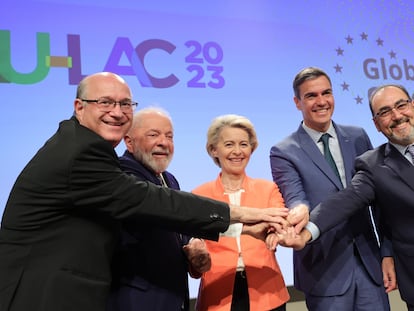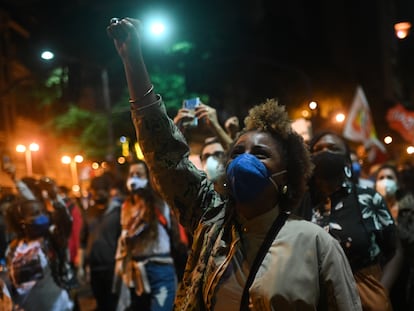Inclusion and transparency: the challenges of public-private partnerships in Latin America
Infrastructure specialists – who are meeting in Panama at the request of the Inter-American Development Bank (IDB) – agree that the region requires both public and private investment to cover its transportation, health and education needs


Public-private partnerships have long been an option for governments in Latin America to address the needs of citizens, without putting the solvency of public coffers at risk. However, the bar is getting higher for this type of contract or concession to be awarded, since the region now generally requires the inclusion of vulnerable groups and minorities, as well as transparency in the process to avoid corruption or tax evasion. Specialists from the infrastructure sector – who have been meeting this week in the Republic of Panama – have agreed to this, within the framework of the PPP Americas 2023 forum, hosted by the Inter-American Development Bank (IDB).
For Latin America to cover its infrastructure needs, an average investment of $200 billion a year would be required, so that governments could partner with the private sector to finance the critical works. Through public-private partnerships, a government can hire a company to build a project or provide a service, gaining their expertise and labor. This generates income for the private sector, without compromising the solvency of public coffers.
During his welcome message at the PPP (Public-Private Partnership) Americas forum, the executive vice president of the IDB – Jordan Schwartz – emphasized that, for every dollar invested in resilient and sustainable infrastructure, four dollars of economic benefits are generated.
“This doesn’t mean that the [public-private partnership] is the only answer to solve all investment needs, but it’s an important piece of the puzzle,” Schwartz noted, in front of some 250 attendees in the Panamanian capital. “We recognize that there are still sectors that [are skeptical] about public-private partnerships, which is why we’re working to strengthen institutional regulatory frameworks and [clarify infrastructure goals],” he added. Schwartz also reported that, in 2022, the IDB approved more than $3 billion in infrastructure projects in Latin America, while its private arm – IDB Invest – financed $1.25 billion worth of projects.
“In Costa Rica, there’s still resistance to [giving out these] concessions,” says Dahianna Marín, from the National Concessions Council of the Central American country, during a panel where she shared the stage with her counterparts from Chile and Paraguay. “We must reconsider [this kind of partnership] as being beneficial for our country.” She explained that, in the case of one particular public-private project, there has been significant resistance from the local population. She also shared how, due to the discontent of local communities, the country hasn’t been able to build a highway that connects the central region with the west.
“Ten years have passed – we still don’t have a solution for the highway,” Marín laments. “I think it’s important to indicate that… certain social factors were not considered [in the process]. This has led to delays and, as is often said, the public works that are incomplete are the most expensive.”
Specialists who participated in different panels also agreed that public authorities must include minorities and vulnerable populations from the start of the projects. Juanita Merchán – a social worker at the private Bosa Hospital in Colombia – proposed a project design that stems from the needs of the communities, so that they are included from the start.
“We need private investment, of course we do… but for what?” Merchán asked during her panel. “It seems very important to me to ask for some reflection – how are we, as institutions, as private individuals, viewing [the notion of] inclusion? Many times, we show up saying ‘let’s think of poor children, please, let’s think of the Black population, the LGBTQ community, the Indigenous community, let’s include them.’ But beyond just including the communities, we must sit down and talk with them in their territories,” Merchán affirms.
Last year – for the first time in its history – IDB Invest withdrew financing from two hydroelectric plants in Guatemala, after pressure from Mayan groups, who claimed that they hadn’t been consulted by the authorities. After the Indigenous communities demanded an end to the hydroelectric power projects, the bank paid off its debt with the construction company.
This year, the IDB identified six themes under which infrastructure projects should be built, with the potential to be financed through public-private partnerships: climate or sustainable investment, digital transformation, logistics improvement, job creation, promotion of inclusion and social impact measurement. Unlike with purely private investment, alliances between governments and companies must measure their performance, so as to be accountable to the population. They must generate data and draw up best practices.
“In the case of Chile, there’s another dimension of evaluation that occurs,” notes Juan Eduardo Chakiel, head of Financial Analysis at the South American country’s Directorate of Concessions. “This is good and healthy, because it allows a public-private partnership project not to just be a ministry’s project, but a country’s project.”
Although Chile’s Ministry of Public Works is the institution that prepares and structures the infrastructure projects, Chekel acknowledges, the Ministry of Finance is involved in the approval of the bids, based on an evaluation of the fiscal impacts. “It’s about seeing what the fiscal impacts of this project are, because [when] there are subsidies given [to private firms], for example, this will hit the treasury’s wallet. And, in this way, [we ensure that] the concessions don’t become a system to circumvent budgetary restrictions.”
Sign up for our weekly newsletter to get more English-language news coverage from EL PAÍS USA Edition
Tu suscripción se está usando en otro dispositivo
¿Quieres añadir otro usuario a tu suscripción?
Si continúas leyendo en este dispositivo, no se podrá leer en el otro.
FlechaTu suscripción se está usando en otro dispositivo y solo puedes acceder a EL PAÍS desde un dispositivo a la vez.
Si quieres compartir tu cuenta, cambia tu suscripción a la modalidad Premium, así podrás añadir otro usuario. Cada uno accederá con su propia cuenta de email, lo que os permitirá personalizar vuestra experiencia en EL PAÍS.
¿Tienes una suscripción de empresa? Accede aquí para contratar más cuentas.
En el caso de no saber quién está usando tu cuenta, te recomendamos cambiar tu contraseña aquí.
Si decides continuar compartiendo tu cuenta, este mensaje se mostrará en tu dispositivo y en el de la otra persona que está usando tu cuenta de forma indefinida, afectando a tu experiencia de lectura. Puedes consultar aquí los términos y condiciones de la suscripción digital.
More information
Archived In
Últimas noticias
Most viewed
- Sinaloa Cartel war is taking its toll on Los Chapitos
- Oona Chaplin: ‘I told James Cameron that I was living in a treehouse and starting a permaculture project with a friend’
- Reinhard Genzel, Nobel laureate in physics: ‘One-minute videos will never give you the truth’
- Why the price of coffee has skyrocketed: from Brazilian plantations to specialty coffee houses
- Silver prices are going crazy: This is what’s fueling the rally










































